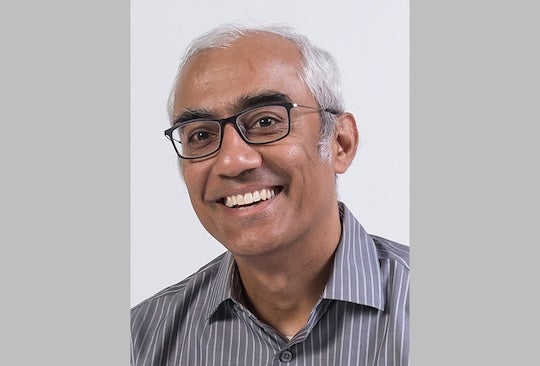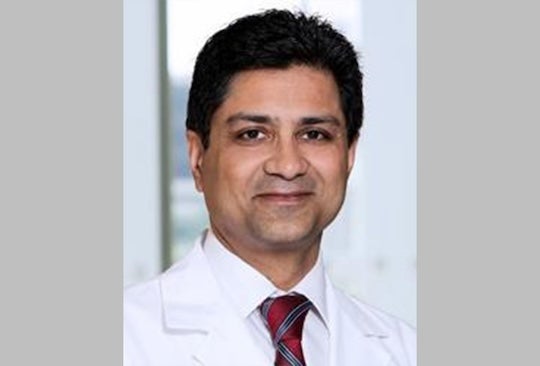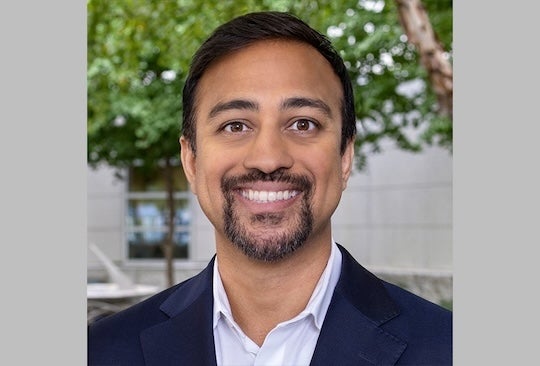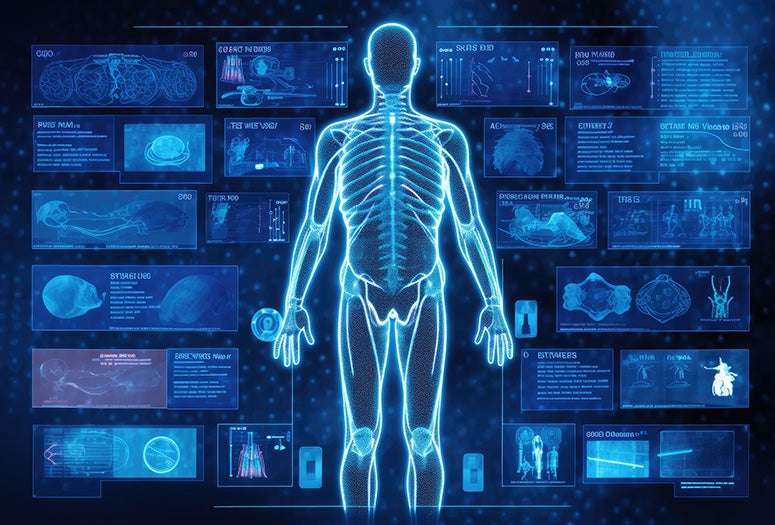
The Houston Methodist-Rice University Digital Health Institute will host its first summit Oct. 8 with a full-day program at Rice’s McMurtry Auditorium. The institute builds on years of collaboration between engineers and physician scientists, uniting Rice’s strengths in artificial intelligence, wearables, robotics, imaging, electronics and computational biology with Houston Methodist’s vast health data infrastructure, implementation science expertise, agile adoption of leading-edge digital technology experience and national leadership in clinical care innovation.
Sitting at the gateway to the Texas Medical Center, the institute aims to accelerate the digital transformation of health care, increasing the efficiency of care, improving patient outcomes and shaping how technologies like artificial intelligence (AI) and real-time monitoring are tested and scaled. In advance of the summit, Rice News spoke with DHI co-directors Dr. Khurram Nasir and Ashutosh Sabharwal as well as executive director Pothik Chatterjee about the institute’s vision, its distinctive assets and the opportunities it opens for the future of health care.
What opportunities in health care do you see the institute uniquely able to address at this moment?

The Digital Health Institute is launching at a pivotal moment in health care. The billions of data points collected in health care systems worldwide surpass the scope of human comprehension, but the potential these data assets hold for the transformation of human health is equally vast, yet the translation has not kept pace. The Methodist-Rice Digital Health Institute was created to build that bridge. By combining Rice’s deep bench in engineering, AI and computing with Houston Methodist’s clinical reach, data and operational infrastructure, we’ve created an environment where ideas don’t just live on paper or in labs; they move quickly into patient care settings, community environments and scalable programs. One of the institute’s most important contributions will be in creating the research and development ready data assets, processes, capacity and training ecosystem needed to make innovation routine rather than exceptional. That means building workflows for implementation science, developing real-world evidence pipelines and training a new generation of hybrid leaders, clinicians who understand tech and engineers who understand medicine. At this moment, health care doesn’t just need more innovation; it needs better systems to evaluate, adapt and deliver innovation where it matters most. That’s the core of DHI’s mission: to ensure we maximize the yield of each byte of data, train the teams who will carry it forward and build a sustainable, collaborative model for health systems across the country and around the world. Five to 10 years from now, success for the Digital Health Institute means we will no longer be talking about digital health as a separate category; it’s simply how care will be delivered. Seamless. Personalized. Preventive. Equitable.
What distinctive assets set the institute apart within the Texas Medical Center ecosystem?
Houston Methodist and Rice University bring independent assets that are truly unique to our academic medical system. These include automation of exclusive data pipelines, access to a wealth of biomedical and computational labs, partnerships with digital health experts at Rice and the involvement of institutional leaders in the entire life cycle of product development. To give you two examples: first, we offer rich, secure and actionable data assets, cross-sectional and longitudinal data on more than 6 million patients, 79 million health care encounters and 1.3 billion clinical facts. Houston Methodist also maintains one of the most real-time streamed physiologic data from the world’s largest MIC Sickbay implementation and systemwide continuous inpatient monitoring through BioIntelliSense wearables. Together, these uniquely multimodal and longitudinal datasets provide an unparalleled foundation for the Digital Health Institute to innovate.
Rice University brings to the table a wealth of engineering and computational expertise, complementing our strengths at Houston Methodist with a diverse range of skills and perspectives. From bioelectronics and imaging to robotics and AI, Rice’s faculty and researchers are at the forefront of innovation, pushing the boundaries of what is possible in health care and data science. In terms of adoption, there is no better place than the Center for Innovation at Houston Methodist, focusing on health care delivery models, prioritizing digital solutions that enhance patient care and engagement. By embracing a consumer-centric approach, the program is addressing the needs of today’s patients but also anticipating and addressing the evolving demands of tomorrow.

Also, we have the perfect capacity for development and commercialization, which is evident through initiatives like the Houston Methodist Center for Innovation, the Rice Biotech Launch Pad, the Rice Ion and a long array of Rice programs to support every part of the commercialization journey. These platforms not only foster the incubation of innovative ideas but also accelerate their translation into real-world applications, ensuring that our advancements reach those who need them most. When viewed collectively, these initiatives represent the essential pieces in the cog, a much-needed perfect synergy to make an impact. In a place like the Texas Medical Center, that kind of integration is rare. Many institutions are strong in research or delivery but not both. DHI gives us the ability to go end-to-end, from breakthrough to bedside, with speed, safety and sustainability. Collectively both institutions have the right pieces in place — world-class facilities, top-tier talent, cutting-edge technology and a shared commitment to excellence — to ensure success in our collaborative endeavors.
Clinician burnout and workforce shortages are among the biggest global health challenges today. How do you see the institute’s work giving time back to frontline staff and improving the patient experience?
The institute’s work directly addresses clinician burnout and workforce shortages by leveraging AI and digital health tools to eliminate administrative burdens, the primary driver of time spent away from patients. One of our key design principles will be “clinical subtraction.” We ask: Can this tool reduce the number of clicks? Can it eliminate duplicative workflows? Can it push information to the right person at the right time, rather than creating more alerts or dashboards? As an example, Houston Methodist is already deploying solutions like ambient AI scribing, where advanced large language models listen to the patient-clinician conversation and automatically draft the clinical notes, orders and billing codes in the background. This frees doctors and nurses from hours of data entry, returning that time for better focus on patient care and work-life balance.
Ultimately, we believe digital health should amplify human connection, not replace it. When designed and deployed well, these tools can relieve cognitive burden, rebuild trust in the system and create space for clinicians to do the work they went into medicine to do.
What does the institute mean for the city of Houston, and how do you see its work making a difference for the people who live here?
As the most diverse large city in America and home to the world’s largest medical complex, Houston is uniquely positioned to lead a new era of health care innovation that is both high-tech and deeply human. The Rice-Houston Methodist Digital Health Institute is a major catalyst for Houston, positioning the city as a global leader in the convergence of engineering, AI and medicine. Its impact will be felt across the Houston economy, workforce and, most importantly, the daily lives and well-being of its residents.
By uniting Rice University’s world-class engineering and AI expertise with Houston Methodist’s national clinical innovation leadership, we are anchoring the city as a global epicenter for digital health innovation. This collaborative ecosystem is designed to translate cutting-edge research, from predictive AI diagnostics to novel imaging and wearable sensors, into viable technologies that are ready for real-world clinical environments. This initiative not only attracts investment and spurs the creation of high-tech jobs in the local economy but also builds a vital talent pipeline through programs that train Houston-area students and educators in these emerging fields.

Our focus is on creating scalable solutions that address major local issues such as health disparities and chronic diseases like diabetes and heart failure. In the long term, we see the institute as a catalyst for making Houston a national model for digital health, a place where innovation isn’t something that happens to communities but with them.
How do you see the institute contributing to solutions that could have impact not just locally but worldwide?
We see the Digital Health Institute as a launchpad for solutions that start in Houston but are designed from Day 1 to be adaptable, scalable and globally relevant The challenges we face here — chronic disease, health disparities, workforce strain, rising costs — are not unique to the U.S. They are global in nature and so are the opportunities to address them with smarter, more equitable models of care.
What makes the institute different is that we’re not just building high-tech solutions; we will be building the infrastructure, evidence and training ecosystem needed to make those solutions transferable across settings. Our tools will be stress-tested in diverse, complex environments within Houston. That means we will scale globally and export systems that have already worked under real-world constraints.
For example, proven by successes like Cognita Labs and Synopic, Rice Digital Health spinoffs. Cognita Labs has developed FDA-approved, low-cost respiratory health products, like smart inhaler sensors and point-of-care testing, and successfully scaled their commercial deployment to over 18 countries. These early spinoffs demonstrate the core principle of our work: Research that begins at the intersection of engineering and medicine in Houston can quickly become a global standard in health care. If we build responsibly and collaboratively, the impact of DHI can and should extend far beyond our city. By consciously designing technologies for low-cost and scalable delivery, the institute ensures its solutions are practical not just for wealthy nations but also for developing regions struggling with limited resources, truly advancing global health for humanity.

